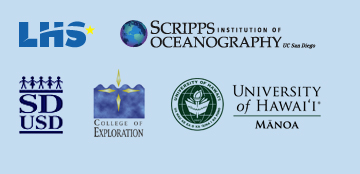You are welcome to download and use these activities.
Let us know how it goes.
Beach Buckets (PDF, 120 KB)
Learners explore a bucket of sand and beach drift and use a model to show how sand could be composed of items found on a beach.
Beach Finds Curiosity Cart (PDF, 174 KB)
Learners investigate objects found on beaches including egg cases, shells, tests, and bones and gain a better understanding of some of the organisms that inhabit local marine habitats and how hard parts of organisms can provide clues about the living organisms.
Crayfish Investigations (PDF, 186 KB)
Learners observe and interact with crayfish (or other live organisms) while facilitators guide them to make observations, ask questions, and engage in investigations to learn more about them. If they wish, learners can set up their own investigation to answer questions they wonder about crayfish.
Exploration Tank (PDF, 139 KB)
Learners are engaged at a marine touch tank exhibit while making careful observations and asking questions about the organisms that they can answer for themselves with additional observations or mini-experiments.
Fish Features and Habitats (PDF, 159 KB)
Learners observe fish behavior while paying close attention to body structures (including tail shape, body shape, and mouth shape and position). Using those observations, they make generalizations about what different body structures and shapes may indicate about fish movement and habitat.
Fish Wheels (PDF, 1.63 MB)
Learners make fish adaptations wheels that allow them to examine different body structures (mouth shape/position/teeth, body shape, tail shape, and coloration patterns) and how their variations allow fish to be successful in their habitats. Based on this information, learners make predictions about the behavior and habitats of fish throughout the aquarium.
Got Seaweed? (PDF, 135 KB)
Learners explore seaweed samples and discover that seaweed plays a more important role in their life than they may think.
Marine Skulls Cart (PDF, 136 KB)
Learners interact with skulls of several marine animals to explore similarities and differences between the animals and how and what they eat.
Sand (PDF, 317 KB)
Learners observe a variety of sand samples with the naked eye and up close (with hand lenses and microscopes). They investigate what their sand is composed of and make inferences about the process and forces that made it.
Shark Cart (PDF, 153 KB)
Learners explore the diversity of shark feeding adaptations and diet by interacting with shark artifacts. Shark teeth are the focus of the activity, but shark senses, anatomy and conservation may also be discussed.
Skin, Scales and Skulls (PDF, 118 KB)
Learners interact with many different “hard parts” of animals and are introduced to the concept that animals have a variety of features that help to protect their bodies.
Tide Pool Survival (PDF, 149 KB)
Learners observe live tide pool animals and use clues from pictures and/or drawings to discover what life is like at the rocky seashore. Using their animal observations and clues, they make predictions about the features and behaviors each animal has to help it survive at the rocky seashore.
Watershed Connections (PDF, 120 KB)
A 3-dimensional topographic model (Enviroscape) of a watershed with various natural and human features is used to illustrate how our land-based actions can and do adversely affect water quality and how our actions can either harm or protect a watershed.
Whale Cart (PDF, 204 KB)
Learners interact with whale artifacts including skull replicas, bones, teeth, and baleen, and learn more about the diversity, biology, and conservation of whales.
This material is based upon work supported by the National Science Foundation under Grant No. 0540417. Any opinions, findings, and conclusions or recommendations expressed in this material are those of the author(s) and do not necessarily reflect the views of the National Science Foundation.


